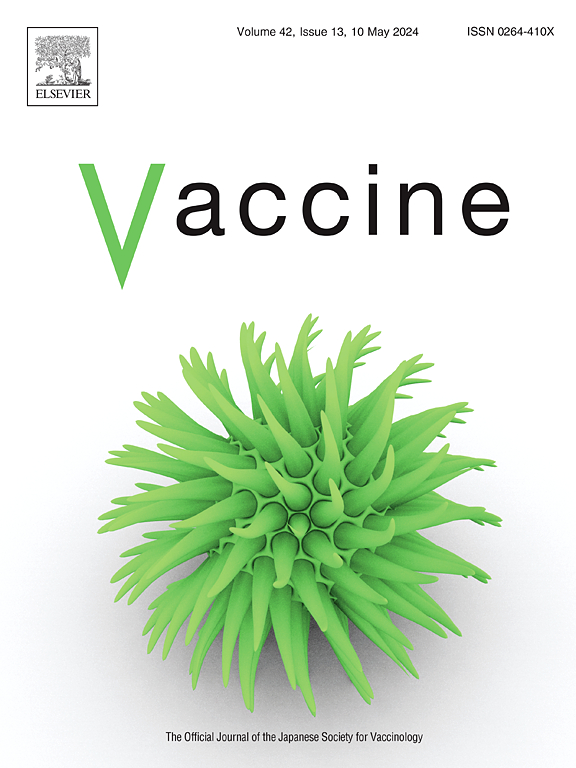IF 4.5
3区 医学
Q2 IMMUNOLOGY
引用次数: 0
摘要
在 2023-2024 年呼吸道合胞病毒 (RSV) 流行季节期间,建议年龄≥60 岁的成年人在与医疗保健提供者共同做出临床决策的基础上接种疫苗。我们研究了符合年龄条件的南加州凯泽医疗集团 (Kaiser Permanente Southern California,KPSC) 患者的 RSV 疫苗接种情况以及与接种相关的特征。我们的研究队列包括 2023 年 9 月 23 日(即 KPSC 首次提供 RSV 疫苗接种的日期;N = 1,003,132 )至 2024 年 4 月 9 日(即当地 RSV 季节结束)期间所有年龄≥60 岁的患者。为了确定与 RSV 疫苗接种相关的社会人口学和临床特征,我们使用多变量稳健泊松回归来估计调整后相对风险 (aRR) 和 95 % CI。总体而言,7.6% 的患者接种了 RSV 疫苗。在多变量回归分析中,与 60-69.9 岁的人群相比,70-79.9 岁(aRR:1.36;95 % CI:1.34-1.39)和≥80 岁(aRR:1.35;95 % CI:1.32-1.38)的人群更有可能接种疫苗。与非西班牙裔白人患者相比,亚裔(aRR:0.95;95 % CI:0.93-0.97)、西班牙裔(aRR:0.52;95 % CI:0.51-0.54)、非西班牙裔黑人(aRR:0.69;95 % CI:0.67-0.71)、太平洋岛民(aRR:0.91;95 % CI:0.84-0.98)和美国原住民或阿拉斯加原住民(aRR:0.80;95 % CI:0.70-0.92)患者接种疫苗的可能性较低。与贫困程度最低的四分位数人群相比,贫困程度较高的四分位数人群接种疫苗的可能性较低(第二季度:aRR:0.86;95 % CI:0.85-0.88;第三季度:aRR:0.77;95 % CI:0.76-0.79;第四季度:aRR:0.67;95 % CI:0.65-0.68)。我们发现疫苗接种率较低,并发现疫苗接种方面的差异可能会加剧某些人群中 RSV 感染和严重 RSV 疾病的现有差异。疾病预防控制中心的 ACIP 最近更新了针对所有 75 岁以上成年人的建议,这可能会开始解决这些差异。本文章由计算机程序翻译,如有差异,请以英文原文为准。
Respiratory syncytial virus vaccine uptake among adults aged ≥60 years in a large, integrated healthcare system in Southern California 2023–2024
During the 2023–2024 respiratory syncytial virus (RSV) season, vaccination was recommended for adults ≥60 years based on shared clinical decision-making with their healthcare providers. We examined RSV vaccine uptake and characteristics associated with uptake among age-eligible Kaiser Permanente Southern California (KPSC) patients. Our study cohort included all patients ≥60 years from September 23, 2023 (i.e., date RSV vaccination first became available at KPSC; N = 1,003,132) to April 9, 2024 (i.e., end of local RSV season). To identify sociodemographic and clinical characteristics associated with RSV vaccination, we used multivariable robust Poisson regression to estimate the adjusted relative risk (aRR) and 95 % CI. Overall, 7.6 % of patients were vaccinated for RSV. In multivariable regression analyses, those aged 70–79.9 years (aRR: 1.36; 95 % CI: 1.34–1.39) and aged ≥80 years (aRR: 1.35; 95 % CI: 1.32–1.38) were more likely to be vaccinated, compared with those aged 60–69.9 years. Compared with Non-Hispanic White patients, Asian (aRR: 0.95; 95 % CI: 0.93–0.97), Hispanic (aRR: 0.52; 95 % CI: 0.51–0.54), Non-Hispanic Black (aRR: 0.69; 95 % CI: 0.67–0.71), Pacific Islander (aRR: 0.91; 95 % CI: 0.84–0.98), and Native American or Alaska Native (aRR: 0.80; 95 % CI: 0.70–0.92) patients were less likely to be vaccinated. Those in higher neighborhood deprivation quartiles were less likely to be vaccinated (Q2: aRR: 0.86; 95 % CI: 0.85–0.88; Q3: aRR: 0.77; 95 % CI: 0.76–0.79; and Q4: aRR: 0.67; 95 % CI: 0.65–0.68), compared with those in the lowest deprivation quartile. We found low vaccination uptake and identified disparities in vaccination that might exacerbate existing disparities in RSV infection and severe RSV disease among certain populations. CDC's ACIP recently updated their recommendations for all adults 75+ years, and this might begin to address these disparities.
求助全文
通过发布文献求助,成功后即可免费获取论文全文。
去求助
来源期刊

Vaccine
医学-免疫学
CiteScore
8.70
自引率
5.50%
发文量
992
审稿时长
131 days
期刊介绍:
Vaccine is unique in publishing the highest quality science across all disciplines relevant to the field of vaccinology - all original article submissions across basic and clinical research, vaccine manufacturing, history, public policy, behavioral science and ethics, social sciences, safety, and many other related areas are welcomed. The submission categories as given in the Guide for Authors indicate where we receive the most papers. Papers outside these major areas are also welcome and authors are encouraged to contact us with specific questions.
 求助内容:
求助内容: 应助结果提醒方式:
应助结果提醒方式:


